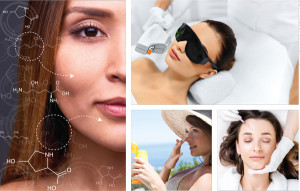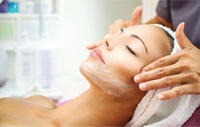Frown Lines Got You Down? | Anti-Aging Tips from Skin Experts


While a suntan was once thought to be a healthy glow, we now know it is anything but healthy. Sun exposure can cause premature aging, like lines, wrinkles and age spots (areas of dark melanin on the skin), and even skin cancer, which can be deadly. So if you once slathered yourself in baby oil to bake in the sun and now live to regret it, we’ve got you covered. We consulted with two top area dermatology groups who revealed the best ways to treat signs of previous sun damage, and prevent further damage. While aging of the skin is inevitable, you can slow the process considerably with attentive care.
Prevent with easy, inexpensive solutions
If you’re concerned with anti-aging skin care, your first-line weapons of choice should be sunscreen and a wide-brimmed hat. “Nothing replaces preventative anti-aging care by using a daily moisturizer with sunscreen,” says Dr. Kappa Meadows, a dermatologist with Dermatology Consultants in Lynchburg. Dr. Meadows recommends a broad spectrum sunscreen of SPF 30 or higher, reapplied every two hours, especially if sweating or swimming. A broad spectrum sunscreen will block both UVA and UVB rays—UVA rays penetrate deeply into skin and cause more wrinkling, while UVB rays penetrate superficially, and cause more of the pigment changes of aging. Keep a tube of sunscreen in your car and your purse and you won’t be caught without it. A wide-brimmed hat will provide extra protection —look for one with a UPF (ultraviolet protection factor), as UPF fabrics block rays. Don’t forget about exposed areas other than the face, like ears, the tops of the hands and feet, and the back of your legs—areas that often get missed with a swipe of sunscreen.
Revamp your daily skin care routine
For aging skin, a mild cleanser that removes makeup and doesn’t strip the skin of natural oils is best. Dermatologists have long recommended Cetaphil, which is available at any drugstore. Many drugstores and chains make a generic version of Cetaphil, which is fine as well. After patting the face dry (don’t get rough with the towel), follow with a moisturizer. “My favorite moisturizers are the ones that contain hyaluronic acid,” says Dr. Meadows, who likes them because they deliver intense hydration. “Hyaluronic acid is naturally found in the skin and acts as a sponge, absorbing up to 1,000 times its weight in water. It leaves skin more supple and smooth,” she notes. Moisturizers with added sunscreen can simplify the routine; if using moisturizer without SPF protection, allow it to soak in before applying a broad spectrum sunscreen. If you want to step it up a notch, add vitamin C to your morning skin care—a vitamin C serum prior to your moisturizer/sunscreen is a common recommendation by dermatologists. A favorite serum of beauty editors and dermatologists is C E Ferulic by Skinceuticals, but other, less expensive options exist too.
At nighttime, follow your cleanser with a retinol-containing product. “Retinol, which is a form of vitamin A, is often referred to as the gold standard of anti-aging,” says Megan Allison, PA-C, who works with patients at RidgeView Dermatology. “Retinoids decrease fine lines and wrinkles by stimulating production of collagen and elastin and increasing cell turnover.” Collagen gives skin strength, while elastin enables your skin to stretch and bounce back, and both decrease with age. Differin gel is a retinoid product that Allison recommends, which was previously prescription-only. You can now find Differin gel in the drugstore aisles. Stronger products, like Retin-A, are available by prescription from a dermatologist.
 In-office treatments: injections and lasers
In-office treatments: injections and lasers
If you are ready to augment good daily skin care with more powerful anti-aging treatments, many options exist. “We have more tools than ever to reduce wrinkles without surgery, including injections and laser treatments,” says Allison. Two popular injectables are Botox and dermal fillers, which go by brand names like Juvederm. “Botox works by temporarily relaxing the muscle movements in your face that lead to creasing of the skin over time,” Allison explains. Botox is often used between the eyebrows and for forehead lines and crow’s feet (laugh lines). Dermal fillers can be used to soften wrinkles, plump the lips, or add volume to the face. “A natural part of the aging process is that our faces tend to lose fat, making creases and grooves more prominent,” says Allison. Dermatologists recommend Botox every three months to maintain results. Dermal fillers are every six to 12 months, so if you go down this path, be prepared to maintain.
 Intense Pulsed Light (IPL) is a treatment for brown spots, redness, age spots and broken blood vessels. It is non-invasive and safe, and uses multiple wavelengths of light to treat sun-induced skin damage. “It’s a great way to remove pigment on the face, help with fine lines and wrinkling and reduce redness,” says Dr. Meadows. “We would usually recommend three treatments spaced one month apart and then maintenance treatments every six to 12 months,” she says.
Intense Pulsed Light (IPL) is a treatment for brown spots, redness, age spots and broken blood vessels. It is non-invasive and safe, and uses multiple wavelengths of light to treat sun-induced skin damage. “It’s a great way to remove pigment on the face, help with fine lines and wrinkling and reduce redness,” says Dr. Meadows. “We would usually recommend three treatments spaced one month apart and then maintenance treatments every six to 12 months,” she says.
There are many different types of laser devices, such as CO2 laser resurfacing, which can tackle deeper wrinkling. However, patients can expect some down time following the procedure, says Dr. Meadows. Chemical peels and microneedling are other procedure options. “Microneedling involves the use of a device with small needles up to two millimeters that penetrate the skin and induce collagen regrowth,” Dr. Meadows says.
If your face does not reflect the youthful vibrancy you feel, devote some extra morning and evening time to applying the products dermatologists say will make a true difference. If you need more antiaging power, set up an appointment with a dermatologist who can guide you on a tailored path to achieve the results you want. And enjoy the sunshine, but do it safely!
anti-aging, Cetaphil, Chemical peels, CO2 laser resurfacing, Dermal fillers, Dermatology Consultants, Hyaluronic acid, inexpensive solutions, injections, Intense Pulsed Light, laser treatments, microneedling, Moisturizers, Retin-A, retinol, RidgeView Dermatology, skincare, Sunscreen






